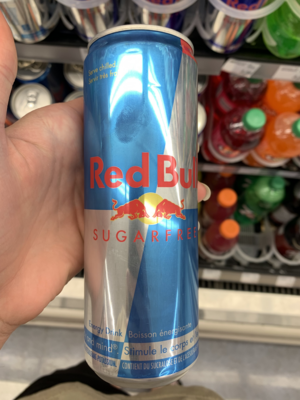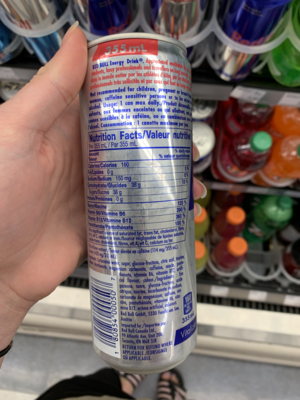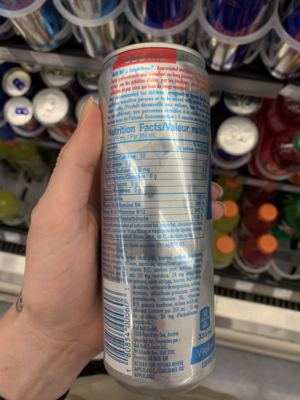Course:FNH200/Assignments/2023/Red Bull Original vs. Red Bull Sugar Free
Red Bull Original vs. Red Bull Sugar Free
Red Bull Energy Drinks are a brand of caffeinated energy drinks that are gluten-free, wheat-free, lactose-free, and dairy-free [1]. The Original Red Bull contains real sugars [2], but also has a sugar-free version containing sucralose and acesulfame K instead to provide a wider variety of product choice to their customers[3]. In this assignment, we will be comparing these two Red Bull products.
Pictures

Include photos of the two products of your choice, clearly showing the ingredient lists and the overall labels - mandatory, if you don't show it, the TA's can't mark the rest.
Instructions on how to add photos and images to UBC Wiki can be found here: https://wiki.ubc.ca/Help:Adding_Media/Images_and_Pictures
The photos of each product and their respective labels / nutrition facts are seen to the right of this section.

Ingredient lists (4 points)
| Red Bull Original | Red Bull Sugar Free |
|---|---|
|
|
- Identify fat substitutes, sugar substitutes, and/or additives used, if there is any: The sugars sucrose and glucose in Red Bull Original have been replaced by the sweeteners Sucralose and Acesulfame K in Red Bull Sugar Free. Xanthan gum is an additive to the Red Bull Sugar Free.
- Explain the roles of fat substitutes, sugar substitutes, and/or additives used in terms of the functional properties they contribute to the product: Sucralose and Acesulfame are non-caloric sweeteners used in Red Bull Sugar Free in replace of sugar. They are not metabolized by the human body, passing through unchanged. Both sweeteners are also not fermented by oral bacteria, and do not contribute to cavity formation. Xanthan gum: A thickening agent produced by bacteria, used to give the drink a better mouth-feel.
- Compare and contrast the lists of the two products and explain differences: Differences in the ingredients lists shown above include Glucose-Fructose in Red Bull Original, and in Red Bull Sugar Free there is Acesulfame-potassium, Sucralose, and Xanthan gum. The rest of the ingredients listed are found in both of the drinks we are comparing.


Labels (1 points)
- Provide detailed description of the information found on the labels
- Indicate whether the information complies with the regulatory requirements as outlined in Lesson 04.
| Red Bull Original and Red Bull Sugar-Free | |
|---|---|
| Common Name | Red Bull, and Red Bull Sugar-Free |
| Bilingual Labelling | English and French information are written side by side, commonly separated with a "/". |
| Country of Origin | From Red Bull GmbH in Austria, Imported by Red Bull Canada Ltd |
| Date markings & Storage Instructions | There is typically a best before date listed on the bottom of the can. As they have a shelf life longer than 90 days, the storage instructions are not required[4] |
| Name & Principle Place of Business | Principle place of business is in Austria. Canada gets the drinks imported in by Red Bull Canada Ltd. |
| Legibility & Location | The labelling information is clearly printed out and the drinks are easily accessible in Canada. |
| Irradiated Food | N/A |
| List of Ingredients | List of Ingredients are seen in the "Ingredients" section above. |
| Net quantity | 355mL per can |
| Sweeteners | Sugar and glucose-fructose in Red Bull Original. Sucralose, acesulfame K in Red Bull Sugar-Free. |
| Claims and Statements | Not recommended for children, pregnant or breast-feeding women, caffeine sensitive persons. Not to be mixed with alcohol. Usage: 1 can max daily. High caffeine content at 114mg/355mL. For the Sugar-Free, it also states that it contains aspartame and acesulfame-potassium. |
The information on the labels comply with the regulatory requirement as outlined in Lesson 04.
Personal Choice (5 points)
Please submit your individual component of this assignment on Canvas to protect your privacy and your personal opinion
References
Please use the Wikipedia reference style. Provide a citation for every sentence, statement, thought, or bit of data not your own, giving the author, year, AND page.
Note: Before writing your wiki article on the UBC Wiki, it may be helpful to review the tips in Wikipedia: Writing better articles.[5]
| This Food Science resource was created by Course:FNH200. |
- ↑ "Red Bull Wikipedia". Red Bull Wikipedia. Retrieved July 15, 2023.
- ↑ "Red Bull". Red Bull. Retrieved July 15, 2023.
- ↑ "Red Bull". Red Bull. Retrieved July 15, 2023.
- ↑ "Inspection Canada". Inspection Canada. Retrieved July 15, 2023.
- ↑ En.wikipedia.org. (2018). Writing better articles. [online] Available at: https://en.wikipedia.org/wiki/Wikipedia:Writing_better_articles [Accessed 18 Jan. 2018].


